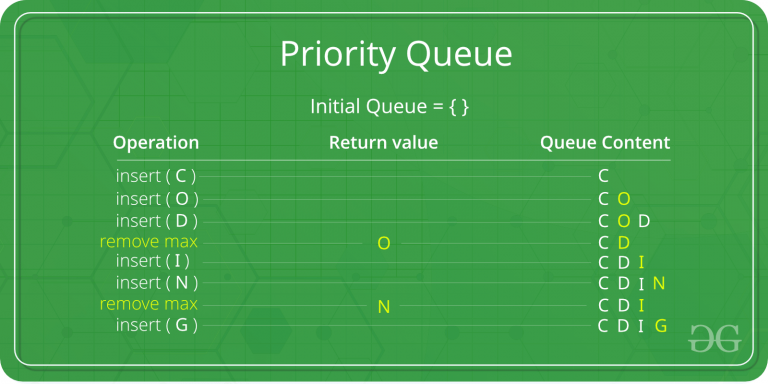Priority Queue
Overview
Priority Queue is an extension of queue with the following properties:
- Every item has a priority associated with it.
- An element with high priority is dequeued before an element with low priority.
- If two elements have the same priority, they are served according to their order in the queue.

In this example, element with maximum ASCII value will have the highest priority.
Applications
- CPU Scheduling
- Graph algorithms
- Dijkstra’s Shortest Path
- Prim’s Minimum Spanning Tree
- etc…
- All queue applications where priority is involved.
Common Procedures
- insert(item, priority)
- getHighestPriority()
- deleteHighestPriority()
Design & Implementation
- Array Implementation
- Heap Implementation
Array Implementation
- Simple implementation
insertcan be implemented by adding an item at end of array inO(1)time.
Heap Implementation
- Better performanced compared to arrays or linked list.
- With a Binary Heap,
getHighestPriority()can be implemented inO(1)time,insertinO(log n)time anddeleteHighestPriority()can also be implemented inO(log n)time (most common implementation). - With a Fibonaci Heap,
insertandgetHighestPrioritycan be implemented inO(1)amortized time anddeleteHighestPriorityinO(log n)amortized time.
Implementation Examples
Java
java.util provides PriorityQueue<E> class that implements Serializable, Iterable<E>, Collection<E>, Queue<E> interfaces.
Some important points:
- It provides
O(log n)time foraddandpollmethods. - Doesn’t permit
null. - Can’t create PriorityQueue ob Objects that are non-comparable.
- Unbound queues.
- If multiple elements are tied for least value, ties are broken arbitrarily.
- Is not thread-safe (Java provides
PriorityBlockingQueueclass that implements theBlockingQueueinterface).
See more examples in my [Datastructures in Java repository]((https://github.com/herrera-ignacio/datastructures-in-java/tree/master/src/main/java/linear/queue)